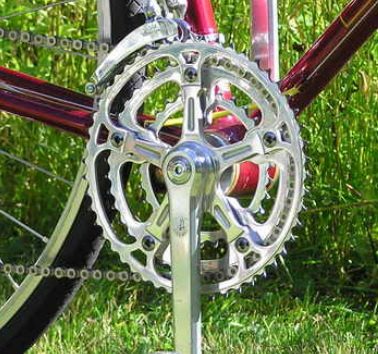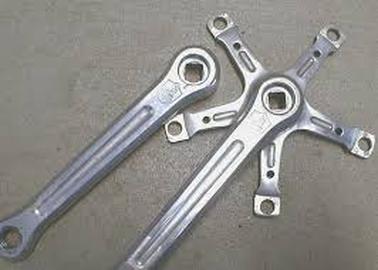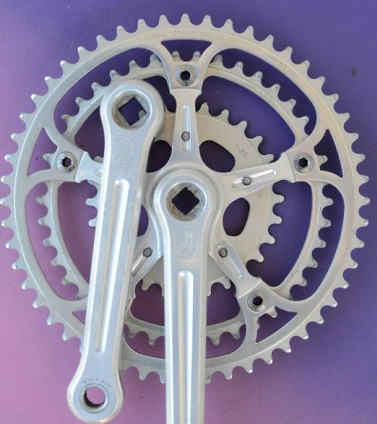
Here's Nuovo Record crank fitted with a conventional outer ring made by TA, a TA triplizer ring in the middle position, and a TA granny ring bolted to the triplizer. Note how the "arms" of the triplizer ring are slightly wider than the crank spider arms themselves. This shows most clearly at the arm in the 9:30 position.
Thanks to Bob Merrill at The Freewheel Spa for the photo.
Bob Freeman at Elliot Bay Cycles in Seattle (elliott baybicycles.com) has been doing this conversion for the last twenty years, and has a reputation for doing great work. A nice step-by-step pictorial of the conversion process is available at https://www.flickr.com/photos/8379107@N03/sets/72157622574585267.)
[Update as of November, 2018: Although Elliot Bay Cycles closed for good in September of 2014, Bob is still drilling cranksets in his home shop. He can be reached by email at [email protected]. He's also offering CNC-machined 30-tooth rings for stock Campy triples in the original 100mm BCD.]
Tighter Spacing
In one important respect, Freeman's approach is an improvement on factory-made
Campagnolo Record triples, which were manufactured from about 1973 until the mid-80s. Those original Campy triples used the same basic design and mounting-bolt system, but were drilled for inner rings with an oddball 100mm BCD.
Rings in that size were available only from Campagnolo, and only in a 36-tooth version. Framebuilder and machinist Jim Merz later produced aftermarket rings in sizn to 31 teeth. (For an interesting look at the history of crankset design—and why Campagnolo, among others, once seemed to have so little interest in offering reasonably low gearing—see http://janheine.wordpress.com/2011/09/07/history-of-aluminum-cranks.)
But when mounting bolts are tapped into an existing double crank, their placement is somewhat flexible. It's possible to stay with the old Campy 100 BCD standard if originality is the goal, although in that case it would probably be better to find a factory-produced triple. The old 84 BCD standard used by Stronglight and SR until the mid-1980s is another option, and will allow use of inner rings as small as 28 teeth. But the most convenient option by far is to drill for the modern 74 BCD standard, which allows the modified crank to accept a wide range of currently-manufactured chainrings in sizes down to 24 teeth.

A factory-drilled Record Triple, made for the exclusive-to-Campy 100 BCD inner ring. Note how the fluting on the crankarms stops short of the bolt holes.
Photo lifted from Ebay.
As best I can judge (but remember, as a guy who make triplizer rings I'm hardly impartial), here are the pros and cons of the two approaches:
Cost: If you buy it directly from me, a 144 BCD triplizer will cost you $102. You’ll also need an inner chainring--which will probably cost about $40 if you buy one new--and a $20 set of comventional chainring bolts and 3.8 mm spacers. The inner ring is a stock item--no need to modify it in any way.
[Another update: For the benefit of future triplizer historians, if any, I'm leaving the prices mentioned in the paragraphs above and below as they originally appeared. But needless to say, it's not 2014 anymore. Current prices for my stuff appear under the "Store" tab on my web site. You'll have to contact Bob Freeman directly to get his]
Elliott Bay charges $40 for drilling and tapping the crankarm, plus another $40 for the specialized 6mm conversion bolts needed to fasten the inner ring to the arm. They’ll provide a generic inner ring in 28-30 teeth for $30, or a TA ring in 26-32 teeth for $60. That includes drilling and counterboring the holes in the inner ring from the original 8mm to 10mm, as required by the conversion bolts. If you later want to switch inner rings, you'll have to take the new ring to a machine shop and have it drilled out the same way.
In either case, you'll also need a new, longer bottom bracket. A modern square-taper Shimano cartridge bottom bracket--at $20-30--is the most economical option. If you have an existing cup-and-cone bottom bracket you're happy with, you may be able to find a longer spindle that will allow you to keep using it, although mixing and matching between manufacturers may take a fair amount of trial and error. (See the "Installation Notes" section of the web site for more detail on this.)
Flexibility: For the time being, at least, the 144 triplizer will be available only in the 42-tooth size. That should work for most users, but those who want a 44-, 46- or 47-tooth triplizer ring for an old-school half-step-and-granny setup are out of luck, at least for now. I may add rings in those or other sizes later if there’s enough demand.
A drilled crankarm, on the other hand, will accept any size middle ring. Crossover, half-step, step-and-a-half—any sort of wacky setup is possible as long as it’s based on standard-sized middle and outer rings.

Compare this photo (also shamelessly lifted from Ebay) to the image above. You have to look closely to see it, but here the bolt holes in the crankarms extend through the longer flutings, indicating that they were retrofitted into what was originally a double crank. The holes themselves are spaced for a bored-out 74 mm ring.
The extra mounting holes don't seem to have any effect on the strength of the crankarms of either the factory-drilled or modified versions. I've never heard of one breaking there.
The "arms" of a triplizer ring, on the other hand, extend slightly beyond edges of the arms on the crankarm spider, giving the assembly a subtly—but if you really look, noticeably—different appearance (see photo at top). That looks fine to me--but of course, it would. What really matters is how it looks to you.
Intangible, But Decisive for Some: Quite a few old-bike dweebs, including me, just don’t like to drill holes or otherwise permanently modify nice old bike parts. They (or I guess I should say “we,”) are happy to make any kind of nut-and-bolt modifications, as long as those changes can later be reversed. If you fall into that camp, you may prefer to bolt on a triplizer ring rather than having holes drilled in an original double.
 RSS Feed
RSS Feed